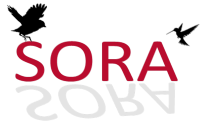Icterus Bullocki as a Honey Eater
Icterus bullocki as a Honey-eater
While preparing some skins of the Bullock oriole last spring (1903) I noticed that the neck feathers of several were considerably soiled by honey that oozed out of the bill and a shot hole in the crop. I remember that this particular male was running honey from its mouth when I picked it up. I had shot it to see why it was feeding so earnestly from the heart of certain blossoms, as I had often observed them to do before, on their first arrival in the spring. Numerous insects are attracted by the sweets of the eucalyptus flowers, which afford many of our small birds--such as Demfroica auduboni, D. coronata, Calypte anna, Regulus calendula, Carpodacus m. frontalis, and various juncos--food throughout the winter. The orioles delighted in sipping blue gum honey in preference to hunting insects through the orchard or creek trees. During the past winter large numbers of Audubon warblers were continually fluttering over the eucalyptus blossoms, picking insects or drinking honey. Many warblers were noted as having a black sticky substance adhering to the feathers about the bill. This is derived from the pollen and honey of eucalyptus flowers, combined with dirt from the ground, where the birds feed on cold mornings, when there is no insect food moving at large. On several occasions Scolecophagus cyanocephalus were seen feeding from the blue gum blossoms.
W. OTTO EMERSON
Haywards, Cal.

